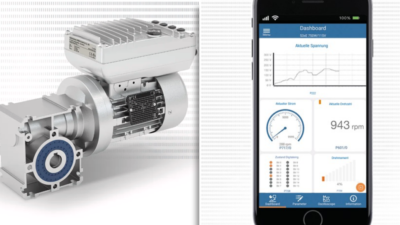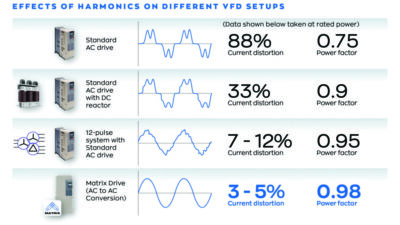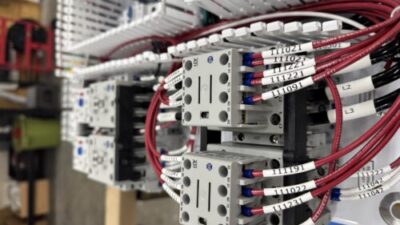As industries realign and companies look to protect assets and leverage capital budgets to the fullest, machine owners are motivated to delay the purchase of new equipment and make strategic investments in existing machines to keep them running longer. Old machines often can be made to function like new; retrofits to control systems and human interfaces help information flow. See photos.
AT A GLANCE
Early Ethernet adoption
Rapid ROI
Increased productivity and reduced costs
As industries realign and companies look to protect assets and leverage capital budgets to the fullest, machine owners are motivated to delay the purchase of new equipment and make strategic investments in existing machines to keep them running longer. Old machines often can be made to function like new, however; with retrofits to control systems and human interfaces, they can achieve new high levels of automation.
An example of a company exploiting this trend is International Paper (IP). When this paper and packaging products company recently purchased a Weyerhaeuser corrugated paper manufacturing operation, management decided to relocate some of the equipment to International Paper’s facility in
Concept Systems pre-wired the I/O racks and control panels before shipping them to the machine re-assembly site.
Butler, IN, and simultaneously upgrade a machine.
Even before the International Paper acquisition, the managers of the Weyerhaeuser plant were considering making strategic upgrades to a Gopfert Flexo Press, a machine that prints, cuts, and creases corrugated paper and stacks it for folding into boxes. Some of the I/O functions of this 15-year-old machine weren’t operational, finding repair parts was difficult, and the machine wasn’t powering up correctly. In addition, the setup process required to change box configurations took more than an hour to complete. This was partly due to problems machine operators were having, and also due to automation limitations in the original design.
For example, one of the more time-consuming aspects of the setup process involved manual positioning of cutting heads. After initial positioning of the heads, test boxes were run, adjustments were made, and more test boxes were run. Often, even more adjustments and tests were done before a production run could be initiated. And when things didn’t work correctly, the system’s monochrome green operator screen provided only limited information for resolving problems.
Move and upgrade
When the decision was made to upgrade the machine, IP’s management hired Albany, OR, systems integrator Concept Systems Inc. to make the modifications. Concept Systems has a long track record in all aspects of the converting industry, and the company had previously upgraded another corrugated press machine for IP with good results.
One new challenge was that this machine needed to be upgraded as the system was moved to the new plant location, with downtime kept to a minimum, since this machine produced all the boxes for a large, vinyl siding customer. To reduce impact on the customer, IP’s team did a large pre-run of product, and the Concept Systems retrofit team did as much pre-work as possible before the machine was disassembled.
Since the other machines at IP’s Indiana plant use Rockwell Automation Allen-Bradley control systems, it was decided to replace the old PLC with a new one from Rockwell Automation. This would minimize the cost of servicing the control systems.
Infeed view of corrugated paper press.
How to rewrite ‘lost’ code
Making the change in control system architectures wasn’t a trivial process, however. In fact, the original machine manufacturer said that it couldn’t be done. “We had to reverse engineer the existing machine,” said Concept Systems’ Bob O’Brien. “We had to learn the machine from an outside perspective.” Three Concept Systems engineers went to Michigan for the task. To figure out the ladder logic of the old PLC without the benefit of a software listing, they researched drawings and crawled around the machine. They talked to the operators and asked questions about the machine operation, and consulted with an outside service technician who was very familiar with the machine.
Beyond understanding how this particular machine worked, the Concept team had to write the code for the new controls before the old controls were replaced.
In addition to replacing the PLC, the Concept Systems team upgraded other hardware where it made sense, while preserving system elements. For example, the machine contained approximately 64 separate motors, seven of them servos. Concept’s engineers replaced the machine’s servos with Allen-Bradley 1326 motors, but other motors and drives—such as the 480 V motors with analog drives and on-off controls—were kept.
Printed and cut corrugated box flats are stacked at the output of the machine.
How to speed I/O replacement
The old system had a large amount of distributed I/O. There were 23 locations around the machine where the old I/O modules were replaced with new A-B 1794 Flex I/O modules. The old cards were mostly 8-point interface modules.
To simplify the task of installing the new modules without changing all the machine’s wiring, the Concept team emulated the setup and functionality of the old cards with the new A-B I/O. “We wanted the electricians on site to be able to replace the old I/O by making simple point-to-point connections,” said Jim Ford of Concept Systems. For example, the old system had control cards with DB25 connections on them, so Concept provided DB25 split-out boards. This allowed the existing wiring to connect to the DB25 connection, and the new I/O modules to wire directly to terminals on the split-out boards.
In addition, where a new Allen-Bradley I/O module did not provide the same functionality as the older I/O interface, rather than replace field devices and/or rewire the entire system to suit the new module, Concept’s engineers programmed add-on instructions for the A-B PLC. These emulated the functionality of the older specialty modules and enabled all existing field devices to be reused in conjunction with the existing field wiring, saving substantial I/O checkout and start-up time.
Absolute positioning added
Where better technologies could be substituted easily, it was done during the retrofit process. For example, many of the old quadrature sensing devices, which required homing operations to measure axis positions correctly, were replaced with new synchronous serial interface (SSI) devices that do absolute positioning. (The old devices that required homing caused delays in getting the system back on-line whenever there was a power outage.) To minimize time required to install the new I/O connections, Concept constructed the new I/O racks in advance and mounted the new encoders on the old machine before the parts were shipped to the new site.
Maintenance screen gives status of all I/O points.
Operator screen shows machine setup.
Operator interface makeover
The machine’s operator interface received a significant makeover. The green monitor was replaced by a 17-in. touch screen running Rockwell RS Studio software. Different production options now can be expressed in recipes, and up to 300 processing scenarios can be stored on the machine.
Operators load a job by selecting a recipe via the HMI, which causes the cutting and material transport motors to go to their preset positions. Then they push a button, and the machine runs. Operators can run just one test box, and they’re ready to go to full production (this is called “one box setup.”) With the new controls and HMI, changeover time is nearly an hour less.
Now, if a problem occurs, service people can look at all I/O points and register values and monitor all Ethernet connections. International Paper’s IT department also will be able to view the system remotely from its Oregon headquarters via a virtual private network (VPN), using the remote link to do diagnostics when necessary.
According to Kevin Klodzen of International Paper, “Due to Concept Systems’ superior engineering process and attention to customer support, we had the machine up and running almost two weeks ahead of schedule. And Concept engineers were with us after startup… to ensure that we made the best use of the new systems.”
When machines are being moved is a good time to consider making changes—but detailed planning is required to make the transition happen as smoothly as possible. In this example, Concept Systems made the controls of an old converting machine more efficient, enabling operators and service technicians to spend time more efficiently.
From the 2009 edition of the Automation Integrator Guide, a supplement to Control Engineering magazine. https://www.controleng.com This annual print guide to nearly 1,800 automation system integrators is searchable online at https://www.controleng.com/integrators .
See other articles in the 2010 Automation Integrator Guide .



